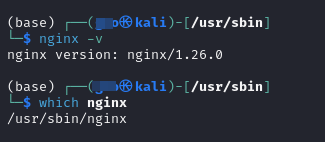kali中使用nginx
大约 3 分钟
kali中使用nginx
1.查看nginx信息
kali中已经安装好了nginx服务,使用如下命令查看nginx版本。
#查看nginx版本 nginx -v
#查看nginx可执行文件所在目录 which nginx

2.查看nginx默认配置文件
kali操作系统中nginx服务默认的配置文件在/etc/nginx/目录下,其中sites-available/default文件中包含nginx服务的关键配置,具体配置文件如下:
##
# You should look at the following URL's in order to grasp a solid understanding
# of Nginx configuration files in order to fully unleash the power of Nginx.
# https://www.nginx.com/resources/wiki/start/
# https://www.nginx.com/resources/wiki/start/topics/tutorials/config_pitfalls/
# https://wiki.debian.org/Nginx/DirectoryStructure
#
# In most cases, administrators will remove this file from sites-enabled/ and
# leave it as reference inside of sites-available where it will continue to be
# updated by the nginx packaging team.
#
# This file will automatically load configuration files provided by other
# applications, such as Drupal or Wordpress. These applications will be made
# available underneath a path with that package name, such as /drupal8.
#
# Please see /usr/share/doc/nginx-doc/examples/ for more detailed examples.
##
# Default server configuration
#
server {
listen 80 default_server;
listen [::]:80 default_server;
# SSL configuration
#
# listen 443 ssl default_server;
# listen [::]:443 ssl default_server;
#
# Note: You should disable gzip for SSL traffic.
# See: https://bugs.debian.org/773332
#
# Read up on ssl_ciphers to ensure a secure configuration.
# See: https://bugs.debian.org/765782
#
# Self signed certs generated by the ssl-cert package
# Don't use them in a production server!
#
# include snippets/snakeoil.conf;
root /var/www/html;
# Add index.php to the list if you are using PHP
index index.html index.htm index.nginx-debian.html;
server_name _;
location / {
# First attempt to serve request as file, then
# as directory, then fall back to displaying a 404.
try_files $uri $uri/ =404;
}
# pass PHP scripts to FastCGI server
#
#location ~ \.php$ {
# include snippets/fastcgi-php.conf;
#
# # With php-fpm (or other unix sockets):
# fastcgi_pass unix:/run/php/php7.4-fpm.sock;
# # With php-cgi (or other tcp sockets):
# fastcgi_pass 127.0.0.1:9000;
#}
# deny access to .htaccess files, if Apache's document root
# concurs with nginx's one
#
#location ~ /\.ht {
# deny all;
#}
}
# Virtual Host configuration for example.com
#
# You can move that to a different file under sites-available/ and symlink that
# to sites-enabled/ to enable it.
#
#server {
# listen 80;
# listen [::]:80;
#
# server_name example.com;
#
# root /var/www/example.com;
# index index.html;
#
# location / {
# try_files $uri $uri/ =404;
# }
#}
3.部署web文件
nginx的配置文件中已经配置了根路径:/var/www/html,将web文件放置到该目录下即可。
web文件中需要包含index.html主页文件(即打开网站时访问的第一个页面),且必须放置在/var/www/html目录下。
root /var/www/html;
将/var/www/html目录下的index.html文件重命名为index.html.bak
sudo mv index.html index.html.bak
新建文件index.html并添加以下内容,然后将index.html文件放置到/var/www/html目录下。
<!DOCTYPE html>
<html lang="en">
<head>
<meta charset="UTF-8">
<meta name="viewport" content="width=device-width, initial-scale=1.0">
<title>Document</title>
<style>
* {
margin: 0;
padding: 0;
}
html {
height: 100%;
}
body {
height: 100%;
}
.gradient-bg {
height: 100%;
background-image: linear-gradient(to right, #fbc2eb, #a6c1ee);
}
.login-box {
background-color: #fff;
width: 358px;
height: 588px;
border-radius: 15px;
padding: 0 50px;
position: relative;
left: 50%;
top: 50%;
transform: translate(-50%, -50%);
}
.login-header {
font-size: 38px;
font-weight: bold;
text-align: center;
line-height: 200px;
}
.input-field {
display: block;
width: 100%;
margin-bottom: 20px;
border: 0;
padding: 10px;
border-bottom: 1px solid rgb(128, 125, 125);
font-size: 15px;
outline: none;
}
.input-field::placeholder {
text-transform: uppercase;
}
.login-button {
text-align: center;
padding: 10px;
width: 100%;
margin-top: 40px;
background-image: linear-gradient(to right, #a6c1ee, #fbc2eb);
color: #fff;
border-radius: 8px;
}
.message {
text-align: center;
line-height: 88px;
}
a {
text-decoration-line: none;
color: #abc1ee;
}
</style>
</head>
<body>
<div class="gradient-bg">
<div class="login-box">
<div class="login-header">请你登录</div>
<div class="form-content">
<input type="text" name="username" placeholder="账号" class="input-field">
<input type="password" name="password" placeholder="密码" class="input-field">
<div class="login-button">登录</div>
</div>
<div class="message"> 如果没有账户? <a href="#">请先注册</a> </div>
</div>
</div>
</body>
</html>
4.nginx管理命令
#启动nginx服务
service nginx start
#停止nginx服务
service nginx stop
#查看nginx服务是否启动成功
ps -ef | grep nginx
#强制关闭进程
kill -9 pid(进程号)
5.访问web页面
- 启动nginx页面
- 打开服务器输入 http://localhost:80 即可查看web页面
Loading...
